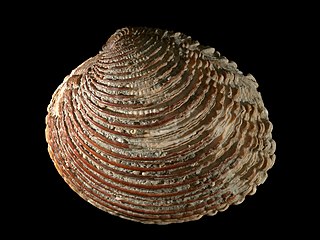
Kiwi or kiwis are flightless birds endemic to New Zealand, in the genus Apteryx and family Apterygidae. Approximately the size of a domestic chicken, kiwi are by far the smallest living ratites.

A wallaby is a small or middle-sized macropod native to Australia and New Guinea, with introduced populations in New Zealand, Hawaii, the United Kingdom and other countries. They belong to the same taxonomic family as kangaroos and sometimes the same genus, but kangaroos are specifically categorised into the four largest species of the family. The term "wallaby" is an informal designation generally used for any macropod that is smaller than a kangaroo or a wallaroo that has not been designated otherwise.

Agathis, commonly known as kauri or dammara, is a genus of 22 species of evergreen tree. The genus is part of the ancient conifer family Araucariaceae, a group once widespread during the Jurassic and Cretaceous periods, but now largely restricted to the Southern Hemisphere except for a number of extant Malesian Agathis.

Nothofagus, also known as the southern beeches, is a genus of 43 species of trees and shrubs native to the Southern Hemisphere in southern South America and Australasia. The species are ecological dominants in many temperate forests in these regions. Some species are reportedly naturalised in Germany and Great Britain. The genus has a rich fossil record of leaves, cupules, and pollen, with fossils extending into the late Cretaceous period and occurring in Australia, New Zealand, Antarctica, and South America. In the past, they were included in the family Fagaceae, but genetic tests revealed them to be genetically distinct, and they are now included in their own family, the Nothofagaceae.

The genus Arctocephalus consists of fur seals. Arctocephalus translates to "bear head."

Neophoca is a genus of the family Otariidae of order Carnivora. It is combined by some taxonomists with the genus Phocarctos, the (extant) New Zealand sea lion. Only one species survives:

Knightia is a small genus of the family Proteaceae endemic to New Zealand, and named in honor of Thomas Andrew Knight. One extant species, K. excelsa (Rewarewa) is found in New Zealand, while a fossil species from upper Miocene deposits in Kaikorai has been described as Knightia oblonga. Two species from New Caledonia, described in the genus Knightia have been placed in the genus Eucarpha by Lawrie Johnson and Barbara Briggs in their influential 1975 monograph "On the Proteaceae: the evolution and classification of a southern family"., although the nomenclatural combinations have never been published as of today.

Sandfly is a colloquial name for any species or genus of flying, biting, blood-sucking dipteran (fly) encountered in sandy areas. In the United States, sandfly may refer to certain horse flies that are also known as "greenheads", or to members of the family Ceratopogonidae. Outside the United States, sandfly may refer to members of the subfamily Phlebotominae within the Psychodidae. Biting midges (Ceratopogonidae) are sometimes called sandflies or no-see-ums. New Zealand sandflies are in the genus Austrosimulium, a type of black fly.

The Veneridae or venerids, common name: venus clams, are a very large family of minute to large, saltwater clams, marine bivalve molluscs. Over 500 living species of venerid bivalves are known, most of which are edible, and many of which are exploited as food sources.

Paphies is a genus of large, edible, saltwater clams, marine bivalve molluscs in the family Mesodesmatidae. The genus is endemic to New Zealand. The species in this genus include the pipi, tuatua and toheroa.
Arthur William Baden Powell was a New Zealand malacologist, naturalist and palaeontologist, a major influence in the study and classification of New Zealand molluscs through much of the 20th century. He was known to his friends and family by his third name, "Baden".

Porrhothele is a genus of mygalomorph spiders endemic to New Zealand. They are the only members of the family Porrhothelidae. They were first described by Eugène Louis Simon in 1892. Originally placed with the curtain web spiders, it was moved to the Hexathelidae in 1980, they were placed in their own family in 2018.

Notocallista multistriata is a marine bivalve mollusc in the family Veneridae
Banksia novae-zelandiae is an extinct species of Banksia, known only from fossil leaves found in the South Island of New Zealand.

Australimyzidae is a family of flies (Diptera). There is 1 genus, containing 9 known species known from Australia and New Zealand and subantarctic surrounding islands. They have saprophagous larvae.

Toronia is a genus of tree in the family Proteaceae that contains a single species, Toronia toru, which is endemic to New Zealand. The genus is closely related to the large genus Persoonia, and in fact this species was long regarded as one until placed in its own new genus by Lawrie Johnson and Barbara G. Briggs in their 1975 monograph "On the Proteaceae: the evolution and classification of a southern family".

Clambidae is a family of beetles. They are known commonly as the minute beetles or the fringe-winged beetles. They are found worldwide on every continent except Antarctica.

Cyclaxyra is a genus of cucujoid beetles in the family Cyclaxyridae, and the sole extant genus in the family, others being known only from fossils. There are two described species in Cyclaxyra, found on the North Island, South Island, and Stewart Island of New Zealand. It is an inhabitant of New Zealand's sooty mould habitat and are mycophagous, feeding on spores, conidia, and hyphae.
















